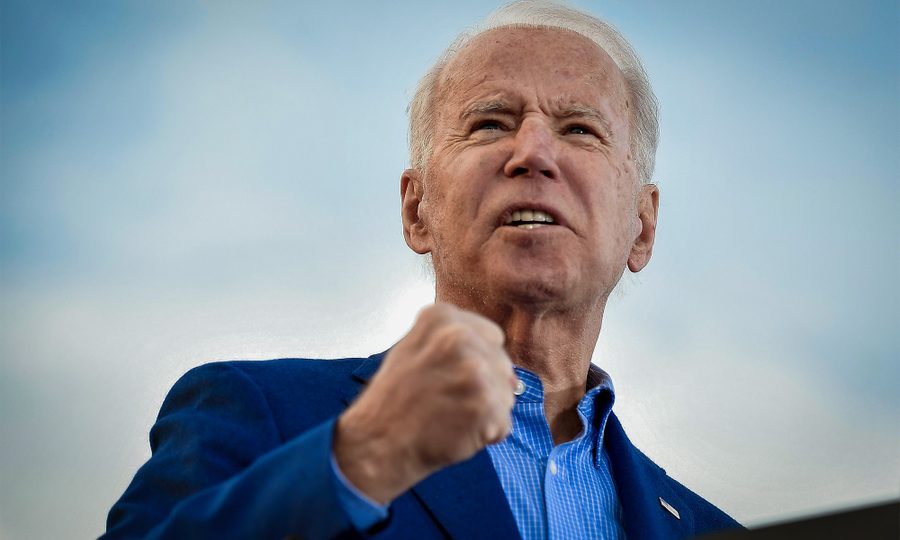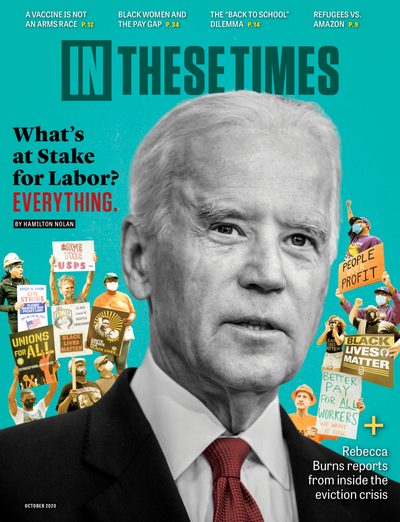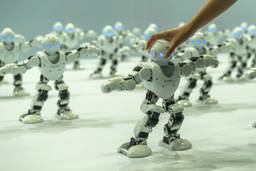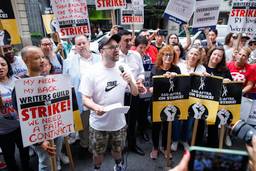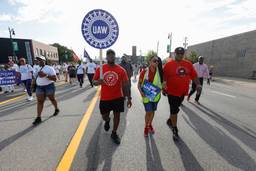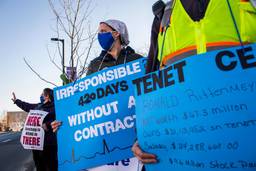Unions hope a Biden presidency will reverse decades of anti-worker policies.
America is in crisis. There can be no doubt about that. All of our immediate crises — the pandemic and the unemployment and the economic collapse and the death spiral of various public institutions — have lent the upcoming presidential election an air of emergency. For working people in America, though, the emergency is nothing new at all. What is at stake for labor in this election is everything. Nothing, therefore, has changed.
Donald Trump and the coronavirus, the two factors infusing this election with urgency, are of recent vintage. But the crisis for working Americans has been growing worse for at least four decades. Since the Reagan era, economic inequality has been rising, union power has been declining, and global capitalism has been widening the chasm between the rich and everyone else.
Organized labor has been fighting a losing — and sometimes ineptly fought — battle against these trends in every election since 1980. The once-in-a-century catastrophe surrounding the 2020 election may be what it needs to finally reverse two generations of disrespect and defeat.
Labor unions, which represent workers in a workplace, have always included people of all political stripes. The labor movement—the broader universe of groups pursuing the interests of working people — will continue to lean left, in the direction that values labor over capital. (Seeing police unions endorse Trump, whose administration is determined to crush labor rights, is an example of the fact that individual unions and their members can act in self-interested ways that go against the labor movement as a whole.)
For roughly the past half century, union households have tended to vote Democratic by about a 60-40 margin, but that margin has fluctuated. In 1980, Ronald Reagan narrowed the gap to only a few points. Barack Obama took the union vote by 34 points in 2012, but in 2016, that gap shrank by half. Democratic presidential nominee Joe Biden, touting his Obama connections and facing an outright incompetent racist, will likely expand that margin again.
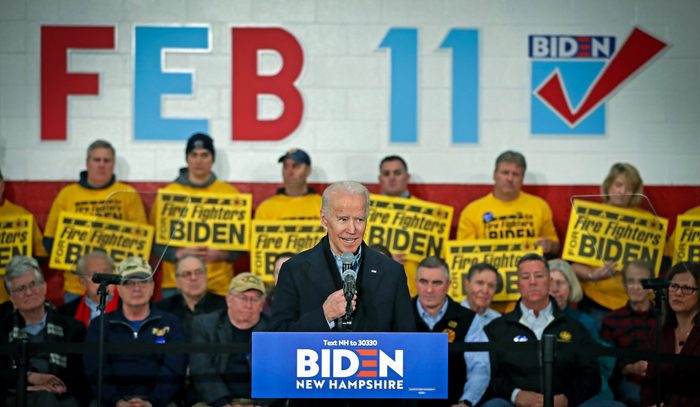
Since Congress passed the Taft-Hartley Act in 1947, unions have been operating in the framework of a set of labor laws designed to rob them of power. The state of those laws today is abysmal. The right to strike is restricted, and companies have been able to classify large swaths of their workers as “independent contractors,” who lack the right to unionize. More than half the states in the country have passed “right to work” laws, which give workers the ability to opt out of paying union dues, making it extremely difficult for unions to organize and maintain membership. The 2018 Supreme Court decision in the Janus v. AFSCME case made the entire public sector “right to work” as well, which is sure to eat into that last bastion of strong union density. The unfulfilled desire to achieve some semblance of labor law reform has been the primary reason that unions in America have poured money into the Democratic Party for decades, despite getting decidedly modest legislative wins in return.
Earlier this year, Sharon Block, a former Labor Department official in the Obama administration who now heads the Labor and Worklife Program at Harvard, and labor expert and Harvard professor Benjamin Sachs spearheaded the assembly of the “Clean Slate for Worker Power” agenda—something of a union-friendly labor law platform for Democrats in exile during the Trump years. That agenda is a fair summation of the labor movement’s wish list. It calls for a swath of reforms that make it easier for all workers to organize and exercise power. Its pillars include sectoral bargaining, which would allow entire industries to negotiate contracts at once; a much broader right to strike; worker representatives on corporate boards; streamlined union elections; more labor rights for independent contractors and other gig workers; the end of statewide “right to work” laws; and stronger enforcement of labor standards. Biden’s own labor platform, while not quite as radical — it conspicuously does not include sectoral bargaining — does include the majority of the Clean Slate agenda. Biden’s platform also says there will be a “cabinet-level working group” of union representatives, which could presumably push his platform even further left. Though Biden was among the most centrist of the Democratic primary candidates, the party’s center has moved so much in the past four years that he has the most leftist labor platform of any nominee since the New Deal.
While Biden is regarded by many as very pro-union, history has taught the labor movement that its greatest challenge will be getting him to actually prioritize labor if he assumes power. “I had the privilege of seeing Joe Biden in action. When he walked into a room where we were discussing policy, we knew that the interests of workers, their collective power, and the labor movement was going to be on the table,” Block says. But, she warns, “It’s critical that in the new administration, labor doesn’t just get siloed: ‘What’s the thing we can do to make the unions happy?’ It’s got to be an approach to looking across everything, especially in light of the economic situation.”
In other words, the new administration must treat organized labor not as a special interest but as the key to changing our increasingly two-tiered economy. That point is key to understanding the divide between the part of the labor movement that supported left-wing candidates like Sen. Bernie Sanders (I-Vt.) and Sen. Elizabeth Warren (D-Mass.), and those that supported Biden. While Sanders’ backers will speak of his fanatical moral devotion to pro-working class policy, Biden’s allies will speak of the personal relationship they have with him. It is the divide between those who see unions more as part of a greater effort to improve conditions for all workers, and those who see them more as a practical tool for members. “Joe Biden had an open door policy. That was the biggest thing. That was the crux of the relationship,” says a spokesperson for the International Association of Fire Fighters, the first big union to endorse Biden when he entered the 2020 race. “With Joe Biden at the White House, our voice is heard. We get priority access.”
This transactional, loyalty-centric approach is unsurprising for a career politician like Biden, but it can leave out labor leaders who don’t have such a long history of backing him. Most major unions did not endorse in the 2020 Democratic primary, preferring to focus on backing whoever became the nominee to oppose Trump. And Biden — though he has many union allies — is not a crusader, but a politician with decades of strong corporate backing, leading many in labor to wonder how much he really means what his platform says. The Biden campaign tried to mitigate that worry by including multiple progressive union leaders in the Biden-Sanders “Unity Task Force,” which was explicitly set up to unify the left and centrist wings of the party, in part by getting progressive policies into the Democratic platform. That task force prodded Biden modestly to the left but not so far as to endorse core progressive ideas like Medicare for All. The unions closest to Biden, particularly the firefighters, are opposed to Medicare for All because they want to keep the healthcare plans they negotiated for themselves.
The biggest labor unions often have strong progressive factions but mostly plant themselves firmly in the Democratic Party’s mainstream. In fact, four major union leaders who serve on the platform committee of the Democratic National Committee voted against including Medicare for All in the party’s platform. One was Randi Weingarten, president of the American Federation of Teachers, who also served on the Biden-Sanders Unity Task Force. She says the DNC platform vote was a result of a prior agreement among those on the Unity Task Force to vote for its recommendations, in the way you might vote for a union contract that was imperfect but the best you could get.
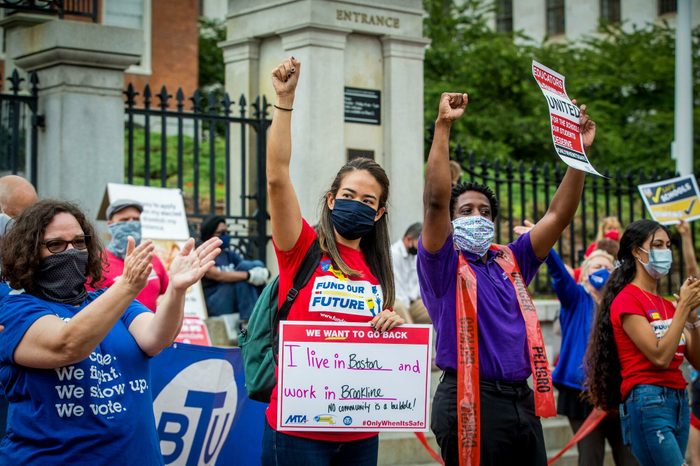
The wretchedness of the Trump administration has pushed unions to view the election as a matter of survival. “What Trump has done with his abysmal handling of Covid, and his even worse handling of racism, is to have sobered up everyone that this is an election like no other,” Weingarten says. “That this election needs to be won by Biden to make sure that our democracy, as imperfect as it is, stays in place. … Yes, it’s aspirational about how we need to do better. But it’s also very primal, about what the stakes are right now.”
The brutal realities of the pandemic mean that many unions are forced to focus on their immediate needs more than on long-term ideological goals. In the February run-up to the Nevada caucus, Joe Biden and the other Democratic primary candidates battled to win the endorsement of the powerful Culinary Union, which has organized the state’s casino industry. (The union ultimately did not endorse, and Bernie Sanders won the caucus.) Less than two months later, the unemployment rate for the union’s members was close to 100%. Geoconda Argüello-Kline, the union’s secretary-treasurer, says the presidential election is now framed in relentlessly practical terms: The refusal of Republicans to deal with the pandemic and the economic crisis show that only Biden can make the government support workplace safety legislation, protect health insurance and pensions, and fund adequate unemployment benefits until Las Vegas is back on its feet.
“The government really has to provide everything that the workers need during this pandemic,” Argüello-Kline says. Her union is adapting its legendary get-out-the-vote machine for a socially distanced era, relying on phone banking, text messaging and digital communication more than door-knocking and rallies. She’s confident that Trump will not carry Nevada. “Everybody in the country sees how he’s being oppressive to minorities over here. How he’s attacking the Latino community. How he doesn’t want to have anybody in this country who doesn’t look like him,” she says. “We know workers never have an easy road.”
Across the country, unions that typically would be spending the summer and fall months focused on electioneering are forced to balance that with the work of triaging the needs of members facing very real life-and-death situations. The Retail, Wholesale and Department Store Union represents front-line retail workers who have been subjected to widespread layoffs that now appear to be permanent. It also represents poultry plant workers in the South who have continued to work throughout the pandemic with desperate shortages of protective equipment. It is hard to tell whether the working members or the unemployed members of the union face more danger. Stuart Appelbaum, the union’s president, has been a member of the Democratic National Committee for decades, but he has never dealt with an election year that combines such dire circumstances for workers with such logistical challenges to mobilize them to fight.
If there is any silver lining, it is that the value of unions is clearer than ever before. Their public popularity is near a 50-year high. Trump’s cartoonish class war lent the Democratic primaries a strong pro-union flavor, and the workplace inequality exposed by the pandemic has only sharpened the recognition of the need for workplace protections. “We heard more talk about unions and support of unions than we’ve heard in any other campaign that I can remember,” Appelbaum says. “There is more of a recognition in the Democratic Party now and in society as a whole as to the importance of workers having a collective voice. I remember when Bill Clinton was first elected, and I’d go to union meetings where people would say, ‘Is the president ever going to mention the word union?’ That’s not a question we have now.”
That, of course, is no guarantee that things will work out in unions’ favor. The right wing’s long attack on organized labor has sapped some of the basic ability of unions to exercise power. No employees have been more directly subjected to that attack than the workers of the federal government itself. The American Federation of Government Employees has butted heads with the Trump administration incessantly over issues such as the lack of paychecks during the government shutdown, efforts to take away collective bargaining rights from hundreds of thousands of employees at the Defense Department, and workers at federal agencies being forced back into the office before the pandemic is under control.
“For us, this election isn’t about party affiliation. It’s not about the daily outrages from Twitter. It’s about our very livelihoods. It’s about our rights and our lives at work,” says Everett Kelley, president of the 700,000-member union. “The issues that our members are facing are really the same issues that face labor as a whole — our members just work in a sector where the Trump administration has the widest latitude to implement its anti-labor policies. But there’s no doubt that they want to export their union-busting playbook from the federal government to the broader public and private sectors.”
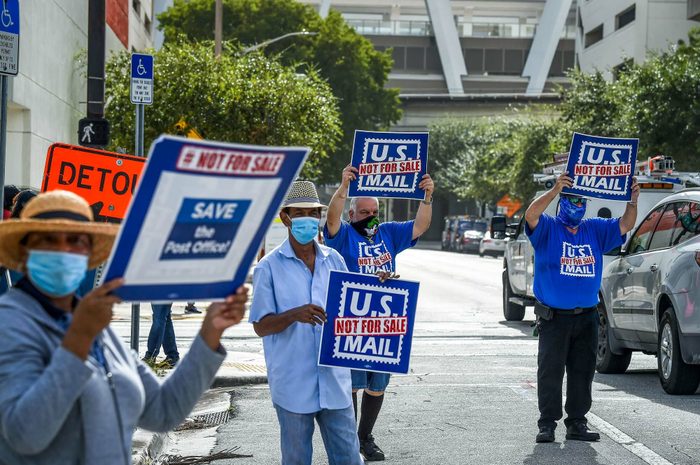
All of the money, email blasts and virtual getting-out-the-vote that unions are engaged in on behalf of the Democratic Party will, if successful, result in millions of mail-in ballots. And all of it will be worthless if those ballots are not delivered and counted properly. Saving the post office — and, who knows, perhaps democracy itself — is a job that has fallen in the lap of the labor movement. Unions have been key players in publicizing the threat to the postal service. They have rallied political support behind postal workers and the popular institution as a whole. What may have been seen as just another underfunded government agency a few years ago is now an avatar of everything wrong with Trumpism.
The U.S. Postal Service is, like many other institutions, facing a pandemic-induced loss of revenue. It is also the target of the Republican Party’s long-term desire to privatize mail delivery and allow corporations to take over its operations. Add to that the president’s apparent desire to sabotage the postal service before the election to prevent mail-in ballots from being counted, and suddenly, the humble post office finds itself at the center of a nation’s sense that the entire government may be teetering on the edge of irretrievable corruption.
“Privatization usually means three things. It means higher prices for the consumer, less services, and lower wages and benefits for the workers,” says Mark Dimondstein, head of the 200,000-member American Postal Workers Union. “This is certainly the fork in the road of whether we’re going to have a public institution that belongs to everybody, serves everybody and is the source of good, living-wage union jobs — or a privatized, broken-up gig economy postal service.”
With tens of millions of Americans unemployed, a deadly disease raging and an incumbent president who appears not to care very much about either crisis, unions and their allies find themselves pushed into a familiar corner: Fight like hell for the less-than-ideal Democrat — mainly because there is no alternative. Joe Biden is an imperfect ally. His record is business-friendly, and his labor platform, though strong in theory, is not as aggressive as those of some of his primary rivals. Labor movement veterans remember 2008 well, when the Obama administration swept in with promise but failed to deliver on the Employee Free Choice Act, which would have enabled “card check” organizing (a method of forming a union with a simple majority vote) and was labor’s main (relatively modest) wish. Biden is selling himself as Obama’s successor. It is up to the labor movement to ensure that a Biden administration does not take them for granted.
“We have to look at a Biden victory not as an end to our work, but a beginning,” Dimondstein says. “The history of this country is, it’s always been the people and the movement, including the working class movement, that have created change in Congress. Not the opposite way.”
That, in fact, is the task that the labor movement — shrunken, battered and divided though it is — should be pouring most of its energy into, even now. Union density in America has fallen by half since the early 1980s. Barely one in 10 workers are now union members. That existential decline must be turned around, or labor will never have enough power to win the economic and political gains that working people need. No new president can do this for the labor movement — they can only remove some barriers to make it easier for the movement to do it for itself.
Biden looks strong in the polls, but there is no certainty about what lies ahead. Few union leaders want to engage seriously with the question of what happens if Trump wins. The answer is always some variation of “Just keep fighting.” But another four years of Trump would be grim, and surviving it would require a ferocious turn toward radicalism. After 2016, some factions of the union world toyed with the theory that the way to meet the moment was to cater to the minority of “white working class” union members who felt left behind and embraced Trump. That approach was always flawed — Trump’s base is the upper, not lower class — and subsequent events have rendered it a moot point. The labor movement has loudly allied itself with Black Lives Matter and pledged to join the fight for social justice. Living up to that pledge means making a choice to oppose Trump. If he is reelected, organized labor should expect to be one of many targets of his vindictiveness.
All of which points to the fact that neither election outcome will mean automatic salvation for working people. The past 40 years of history demonstrate that. Control of the White House has gone back and forth, but through it all, the rich have gotten richer, the wages of working people have stagnated, union density has declined and labor law has remained broken. The worst-case scenario for the labor movement is to see more of the same.
“I don’t really look to the Democrats for leadership; I look to the labor movement,” says Sara Nelson, the head of the Association of Flight Attendants and one of labor’s most prominent progressive voices. “And we have the power to change this right now if we choose to do so. That power is not an appendage of the Democratic Party. It’s our labor. It’s our solidarity,” she says. “As long as we outsource our power to politicians, we are never, ever going to get what working people need.”
The views expressed above are the authors’ own. As a 501©3 nonprofit, In These Times does not support or oppose candidates for political office.

I hope you found this article important. Before you leave, I want to ask you to consider supporting our work with a donation. In These Times needs readers like you to help sustain our mission. We don’t depend on—or want—corporate advertising or deep-pocketed billionaires to fund our journalism. We’re supported by you, the reader, so we can focus on covering the issues that matter most to the progressive movement without fear or compromise.
Our work isn’t hidden behind a paywall because of people like you who support our journalism. We want to keep it that way. If you value the work we do and the movements we cover, please consider donating to In These Times.
Hamilton Nolan is a labor writer for In These Times. He has spent the past decade writing about labor and politics for Gawker, Splinter, The Guardian, and elsewhere. More of his work is on Substack.
